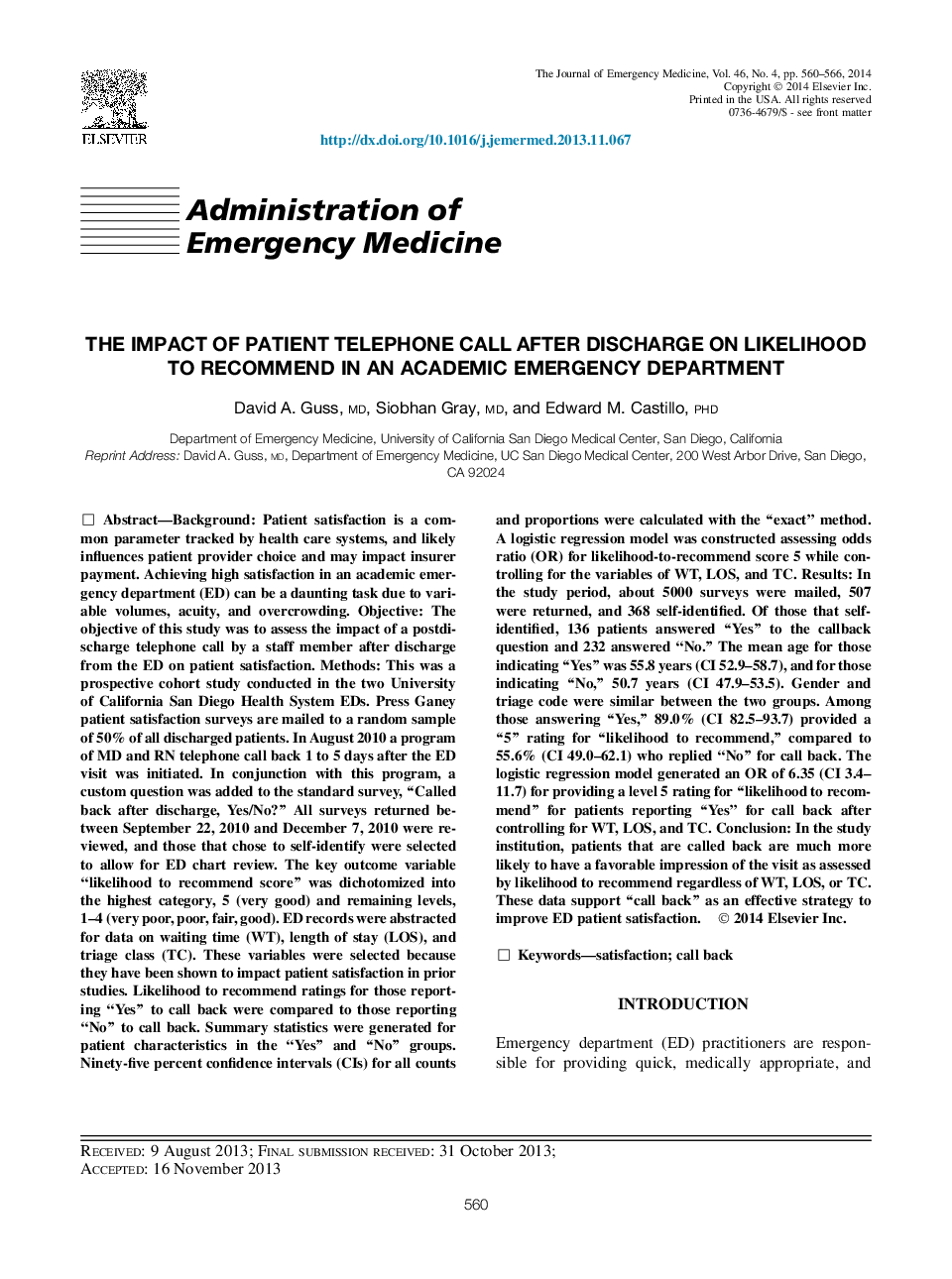| کد مقاله | کد نشریه | سال انتشار | مقاله انگلیسی | نسخه تمام متن |
|---|---|---|---|---|
| 3247424 | 1589138 | 2014 | 7 صفحه PDF | دانلود رایگان |
BackgroundPatient satisfaction is a common parameter tracked by health care systems, and likely influences patient provider choice and may impact insurer payment. Achieving high satisfaction in an academic emergency department (ED) can be a daunting task due to variable volumes, acuity, and overcrowding.ObjectiveThe objective of this study was to assess the impact of a postdischarge telephone call by a staff member after discharge from the ED on patient satisfaction.MethodsThis was a prospective cohort study conducted in the two University of California San Diego Health System EDs. Press Ganey patient satisfaction surveys are mailed to a random sample of 50% of all discharged patients. In August 2010 a program of MD and RN telephone call back 1 to 5 days after the ED visit was initiated. In conjunction with this program, a custom question was added to the standard survey, “Called back after discharge, Yes/No?” All surveys returned between September 22, 2010 and December 7, 2010 were reviewed, and those that chose to self-identify were selected to allow for ED chart review. The key outcome variable “likelihood to recommend score” was dichotomized into the highest category, 5 (very good) and remaining levels, 1–4 (very poor, poor, fair, good). ED records were abstracted for data on waiting time (WT), length of stay (LOS), and triage class (TC). These variables were selected because they have been shown to impact patient satisfaction in prior studies. Likelihood to recommend ratings for those reporting “Yes” to call back were compared to those reporting “No” to call back. Summary statistics were generated for patient characteristics in the “Yes” and “No” groups. Ninety-five percent confidence intervals (CIs) for all counts and proportions were calculated with the “exact” method. A logistic regression model was constructed assessing odds ratio (OR) for likelihood-to-recommend score 5 while controlling for the variables of WT, LOS, and TC.ResultsIn the study period, about 5000 surveys were mailed, 507 were returned, and 368 self-identified. Of those that self-identified, 136 patients answered “Yes” to the callback question and 232 answered “No.” The mean age for those indicating “Yes” was 55.8 years (CI 52.9–58.7), and for those indicating “No,” 50.7 years (CI 47.9–53.5). Gender and triage code were similar between the two groups. Among those answering “Yes,” 89.0% (CI 82.5–93.7) provided a “5” rating for “likelihood to recommend,” compared to 55.6% (CI 49.0–62.1) who replied “No” for call back. The logistic regression model generated an OR of 6.35 (CI 3.4–11.7) for providing a level 5 rating for “likelihood to recommend” for patients reporting “Yes” for call back after controlling for WT, LOS, and TC.ConclusionIn the study institution, patients that are called back are much more likely to have a favorable impression of the visit as assessed by likelihood to recommend regardless of WT, LOS, or TC. These data support “call back” as an effective strategy to improve ED patient satisfaction.
Journal: The Journal of Emergency Medicine - Volume 46, Issue 4, April 2014, Pages 560–566
